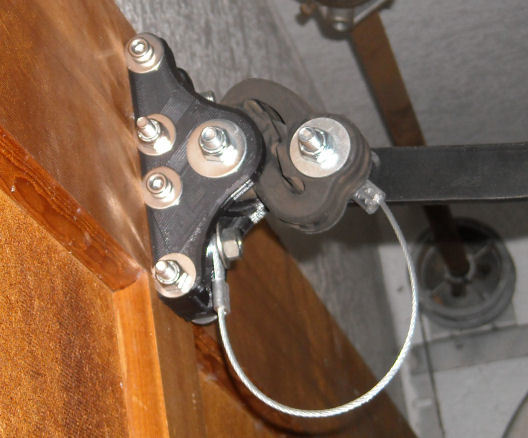
Garage Door Opener Cushion
thingiverse
This is my version of a commercially available garage door opener cushion and expansion joint. The problem that prompted this was that in summertime our wooden garage doors would shrink slightly so that the door openers, if not adjusted, would not fully close them. So insects and debris would have a free path into the garage despite the bottom edge rubber "seal". And then in the wintertime the doors would expand slightly (it rains mainly in the winter here) and so they would slam closed or even trip the force limits in the openers. And they would always start and stop violently with shudders because of the way the openers work. There is a commercially available device that solves these problems nicely. It can be purchased in places such as this- https://www.ebay.com/itm/Commercial-Garage-Door-Opener-ARM-SPRING-BOX/251301576612?hash=item3a82bdbfa4:g:scoAAOSwmtJXUZUS:sc:USPSPriority!95020!US!-1&frcectupt=true These are quite nice, but also can be rather pricey to install if you have more than one garage door (we have three). There is another potential issue with them in that the mounting holes to the garage door are spaced much more widely apart than a normal home opener attachment which would require drilling new mounting holes. So I got to thinking about what these devices really do and came up with the design that is detailed here. It uses a Walker 35119 (or equivalent) rubber exhaust pipe hangar as the spring element. This is both a damper cushion and a compliant element and is very tough. They can be obtained for around $4 each. Example- https://www.autozone.com/emission-control-and-exhaust/exhaust-system-hanger/walker-exhaust-system-hanger/276317_734720_5060 Then with a pair of printed brackets and about $3 worth of hardware available from almost any hardware store, the finished item is as shown. There are no special cautions about printing or using these other than to print with a very high percentage of fill (as close to solid as you can manage). Definitely use a safety lanyard or chain between the door opener arm and the door just in case anything breaks (see photos). I designed it to use the same mounting hole spacing that already existed on our doors and added generous slots to accommodate any variations. I made these in PLA almost three years ago and they have worked beautifully. As you can see in the photos the winter rains have swelled the door so the link is distorted a bit (but that causes no harm). But by mid-summer it will be almost straight again. So far this hasn't caused any problems and adjustments have not been necessary other than to be sure the guide wheels on the door tracks are lubricated and checking that there is not too much friction between the doors and door jambs (both of which should be checked periodically anyway). The cross bolts are 1/4"-20 x 2-1/2". I recommend hex-head bolts, but as you can see I used cap head bolts simply because I had them on hand. The bolts in the rubber link ends are 3/8"-16 x 3" (be sure to use all-thread versions for the door opener arm end so that you can secure it to the arm before attaching the rubber link). Flat washers are used under all the bolt heads and nuts, and "fender" washers are used to constrain the opener arm end of the rubber link (to spread the clamp force). My safety lanyards are each made from 12" of 1/8" steel cable with crimped end ferrules. It is advisable to use lock nuts for the bolts. I purchased most of these materials at our local Lowes, but Home Depot, Tractor Supply, Fleet-Farm, Menards, Ace and others all carry them. The door openers now operate more smoothly and a bit quieter as well. The door may oscillate a little during motions (due to the compliant link) but that would happen with the commercial version too. I adjusted the openers to slightly over-close in the summertime so there is downward pressure to keep the doors firmly closed. Don't over-do the closing pressure of course. If you only have a single garage door, or have extremely heavy doors, you might want to just buy one of the commercial versions. The improvement in the way your garage door openers work will be totally worth it and the drive gears inside them may even last longer (due to less start/stop shock loads). But if you are more of a DIY person or are adventurous, or have more than one door to deal with (as we do), it is far less expensive to make your own. I hope you find this useful, or at least interesting, and thanks for looking. Enjoy!
With this file you will be able to print Garage Door Opener Cushion with your 3D printer. Click on the button and save the file on your computer to work, edit or customize your design. You can also find more 3D designs for printers on Garage Door Opener Cushion.
